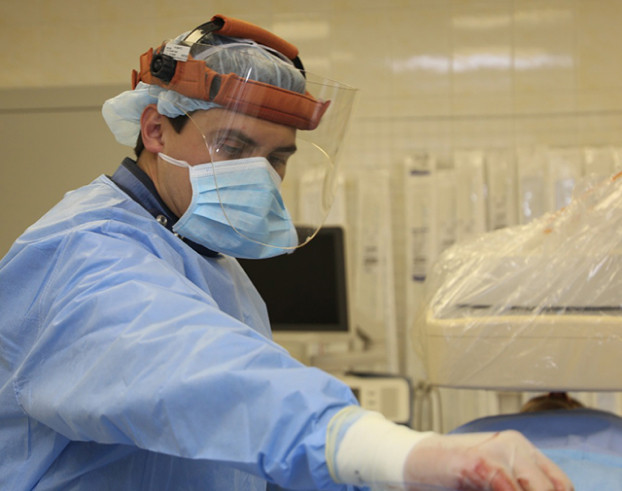Radioembolization for liver cancer
Head of the Academician Lyadov Rehabilitation Center

This award is given to clinics with the highest ratings according to user ratings, a large number of requests from this site, and in the absence of critical violations.

This award is given to clinics with the highest ratings according to user ratings. It means that the place is known, loved, and definitely worth visiting.

The ProDoctors portal collected 500 thousand reviews, compiled a rating of doctors based on them and awarded the best. We are proud that our doctors are among those awarded.

- Treatment of primary liver tumors, including Hepatocellular carcinoma and Cholangiocarcinoma.
- Treatment of liver metastases from a variety of cancers, such as colorectal, breast and melanoma, especially those resistant to standard chemotherapy.
Radioembolization may be an alternative to surgery and chemoembolization under certain conditions, such as portal vein thrombophlebitis or the presence of large tumors. It may also be considered as a life-saving treatment.
Liver embolization for metastatic lesions is relevant when traditional chemotherapy is ineffective or unsuitable. This method can be integrated into complex treatment and also plays a key role in preparation for operations and organ transplants.

Chemoembolization begins with the insertion of a catheter through a vessel in the groin area. This technique involves the use of narrow, flexible tubes to deliver radiopaque contrast material into the hepatic arteries. This approach allows you to accurately determine the location of the vessels feeding the tumor.
Tumor embolization involves two key steps, each of which takes about 7-10 days. At the first stage, detailed angiography is performed to mark the vessels. A radioactive tracer is then injected, which allows the required dosage of treatment to be assessed, eliminating the risk of damage to healthy tissue. This stage can be called "trial".
The second stage of liver radioembolization is the direct administration of Yttrium-90. This isotope, located in microspheres 20-30 microns in size, provides pinpoint radiation within a radius of up to 11 mm, destroying cancer cells while minimizing harm to healthy tissue.
The use of radioembolization is especially important for the treatment of primary and metastatic liver tumors. This method is widely used in leading clinics in Turkey, where it is recognized for its effectiveness and minimal risk of complications.
Helpful information
Description of the procedure
Liver chemoembolization is a complex medical process consisting of two main steps: angiography and a specialized radiation medicine scan, each of which takes approximately 2-3 hours. Typically, after completing these steps, patients are free from radiation exposure within 4-6 hours. In most cases, a one-day hospital stay is sufficient, and sometimes patients leave the hospital on the day of the procedure.
In the process of liver embolization chemistry, local anesthesia is usually used. At this point, patients lie on their backs, remaining motionless throughout the procedure. Pain levels are monitored to ensure patient comfort. After the procedure, serious complications occur extremely rarely, due to which recovery is quick: usually within 1-2 days, patients return to normal life. However, symptoms of fatigue, loss of appetite and nausea may occur in the first two weeks, which are controlled with standard medications. It is worth noting that the side effects differ significantly from those that occur with systemic chemotherapy.
Patients after chemoembolization can safely communicate with other people and use public transport, since the level of radiation after the procedure is minimal and does not pose a threat to others. It is still recommended to follow standard hygiene rules.
In certain cases, a temporary break from chemotherapy for several weeks may be necessary, which should be discussed with your doctor in advance. Sometimes radioembolization is performed in combination with chemotherapy.
The liver embolization procedure helps to reduce the volume of tumor formations, which in some cases opens the way for subsequent surgical intervention.
Criteria for prescribing the procedure
Preparation and criteria for deciding on radioembolization in the case of liver metastases begin with a thorough review of the patient's medical history. This process includes:
- Diagnostic image of a liver tumor.
- Conducting laboratory tests.
- Analysis of the general physical condition of the patient.
- Evaluation of current treatment.
In general, patients with extensive liver disease or advanced disease are not considered suitable candidates for this procedure.
The decision to use radioembolization in the treatment of liver metastases is the result of the joint work of an interdisciplinary group of oncology specialists. This procedure is performed by an experienced interventional radiologist with appropriate qualifications (eg CIRSE accreditation), while a radiation medicine expert plays a key role in determining safe levels of radiation exposure.
Preparation for the procedure
Before the procedure for removing metastases in the liver, you must:
- Consult a qualified interventional radiologist.
- Provide a complete medical history and information about any medications you are taking, including natural supplements.
- Indicate the presence of allergic reactions.
- You may need to temporarily stop taking some medications, such as anticoagulants.
- Fast 6-8 hours before the procedure.
Important! Women should tell their doctor if they are pregnant before treatment.
Rehabilitation and risks from the procedure
During the rehabilitation period after chemoembolization, the patient is prescribed to donate blood for laboratory tests at the end of the second and fourth weeks. The obtained test data is transmitted to the treating doctor. You are also scheduled to see your doctor for a check-up at the end of the fourth week. Three months after the procedure, the patient will be re-evaluated, including scans and blood tests, to assess the effectiveness of the treatment and overall health. Depending on the indication, regular X-ray examinations may be ordered every 3, 6 or 12 months to monitor progress.
Potential risks of liver chemoembolization include:
- Complications associated with angiography, such as bleeding in the groin area, blood clots, risk of infection.
- Possible side effects include gastrointestinal ulcers, pancreas problems, pneumonia, liver abscess or liver failure.
- The need for hospitalization in case of complications rarely occurs due to the qualifications of interventional radiologists.
It should be noted that radioembolization can be repeated in accordance with medical indications, especially if both lobes of the liver are affected. The chemoembolization procedure is a significant element in the complex treatment of liver cancer, effectively combined with other treatment methods, including surgery and standard chemotherapy.
Reviews









About the direction
In the context of oncological practice, aimed at treating cancer pathologies, it is noted that cancer cells demonstrate increased consumption of energy and nutrients compared to normal cells, which necessitates the creation of additional blood flows. In the context of embolization therapies, catheter angiography is used to target agents directly to tumor tissues.
Among the innovative methods, radioembolization stands out, using microspheres with radioactive Yttrium-90, which are sent to the affected area. This method allows you to effectively destroy cancer cells through radiation.